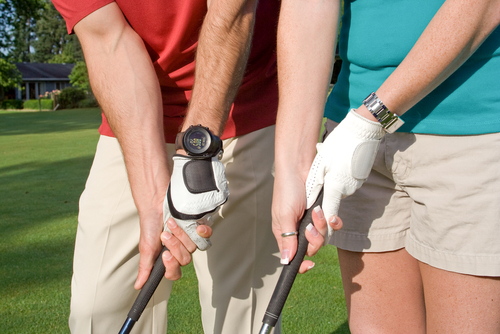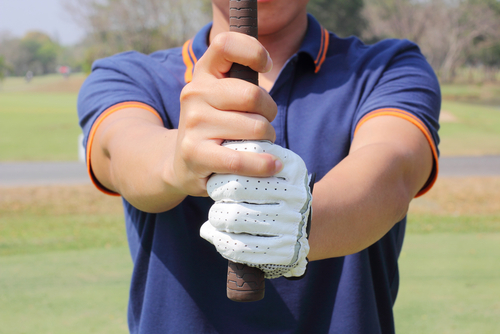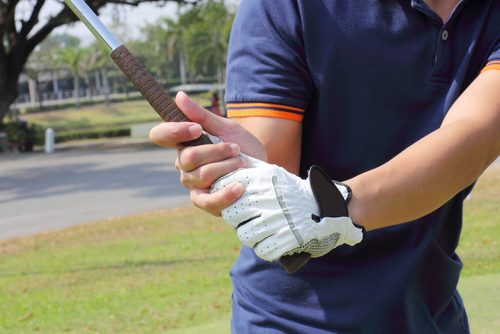4 Steps to Master the Perfect Grip
Aug 2nd 2017

"Good golf begins with a good grip" is a phrase once uttered by American professional golfer Ben Hogan. While this ultimately makes sense to the majority of players and is important for skilled game play, focus on proper grip technique remains overlooked more than any other fundamental of golf.
There is only one physical connection between the golf club and yourself—the grip you use. Along with determining the outcome of your swing, gripping correctly allows you to shoot solid, straighter shots with more power. The way you grip the club governs the face position when impact occurs with the ball.
Since most players are predominately right-handed, the instructions below are written with that stance in mind. If you’re a southpaw, simply swap the hand position in the directions.
Ready to get started? Grab your clubs from the golf cart and follow along to master the perfect grip!
1. Getting Started with Setting the Hands: Left Hand
Allow your arms to fall naturally at your sides from a standing position. Take the handle of the club into your left hand. In correct position, the club's face should be square to your intended target.
Just below the heel pad on your hand is where the butt end of the club should rest, diagonally extending across your fingers. Proper positioning will have the golf club in contact with the base of your pinkie finger and directly above the first joint of your index finger.
The most common mistake is to hold the club in the palm of the hand. In actuality, across the fingers is where the club should sit. Pretend you are looking directly at a clock. Consider the shaft of the golf club to be the twelve o'clock position.
Your thumb should connect with the grip at the one o'clock position. If the steps have been followed properly, you will see your knuckles on the middle and index fingers. Now the golf club is gripped accurately in your left hand.

2. The Right Hand
Take your right hand and place your right thumb with the pad resting over the top of the left one. Exactly as when holding the golf club with the left hand, it should rest across the fingers on your right hand in a diagonal direction.
Refer to your clock image again. The 11 o'clock position is where the right thumb should rest. The grip in your right hand is now also correct.
To confirm you are holding the club correctly with your hands properly positioned, the forefinger and thumb of each hand form a "V-shape" which should be pointing toward the inside of your right shoulder.
Depending on the grip style you prefer, the pinkie finger on your right hand can either interlock with the pinkie from the left hand or simply overlap it. The "V" formation on your right hand should also point toward your right ear. This prevents changes in loft and club face rotation due to repeating ball flight and relieves you struggling to control wedge distances.
3. Golf Grip Style
There are three different styles of golf grips: the baseball grip, the interlocking grip, and the Vardon grip. Each is a personal preference for the individual player.
Junior golfers, people with small hand structures or weak hands, and beginning players will most often use the ten-finger or baseball grip. To imitate this style correctly, place your left hand on the end of the club. Immediately below your left hand, place your right hand on the club.
It should resemble the way a baseball bat is held and can be checked by lifting the club upward above golf cart level, the way you would a bat.
The interlock grip is the next style, and it is the grip of choice for professionals on the PGA Tour, such as Tiger Woods, Jack Nicklaus, and Rory McIlroy. To perform this grip correctly, the pinkie finger on your right hand will hook underneath the left hand's index finger so that it comes to rest between the middle and index fingers.

By far the most popular of golf grips is the Vardon grip, also known as the overlap grip. For this to be done correctly, take the pinkie finger on your right hand and allow it to rest between the space created by the middle finger and the index finger.
4. Grip Pressure
Your fingers are the most sensitive part of the hand. By holding the club more with the fingers, as opposed to the palm, the amount of wrist hinge increases, providing more feel and longer tee shots. The right-hand grip should see the most pressure in the middle two fingers, and the left-hand grip should have the pressure concentrated on the last three fingers
Throughout your entire swing, it is critical to keep the pressure constant. This ensures a good shot with every swing. If we were to use a scale from one to ten, with one being the weakest, the best grip pressure is found around the three or four marks.
Final Thoughts
Even if you have no ambition to be the next Jordan Spieth, you can still improve your golf game. Putting these tips into practice will allow you shoot with more power and more accuracy, improving your overall performance out on the course.
Experiment with the different grip styles until you find the one that works for you—and watch those scorecards burn up!
